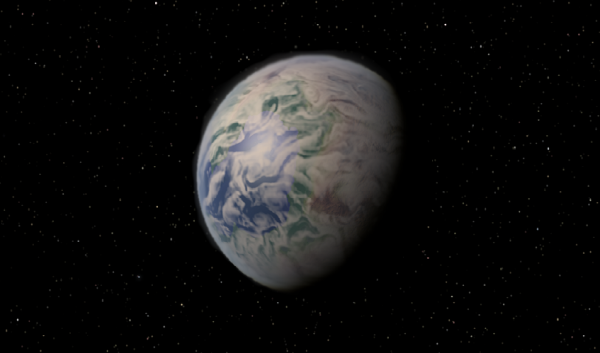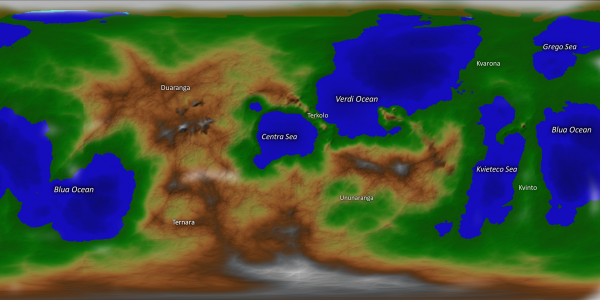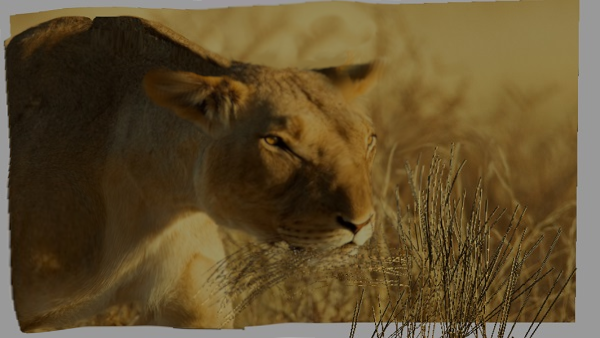BY LETTER
Frog's Head
Galactography > Regions of Space > Inner Sphere
Galactography > Systems and Worlds > Systems & Worlds E - F
Galactography > Systems and Worlds > Systems & Worlds E - F
 Image from Steve Bowers | |
| Frog's Head (originally known as Heket), the superterrestrial world which is home to House Genen | |
Frog's Head (Heket) - Data Panel | |
| Star | Iota Horologi |
|---|---|
| Type | G0 Vp |
| Luminosity | 1.64 x Sol |
| Distance from Sol | 56 ly |
| Constellation | Horologium |
| Colonised | 1611 AT |
| Planet | Bastet |
|---|---|
| Semimajor Axis | 0.9AU |
| Type | warm azurijovian |
| Diameter | 144000km |
| Moons | Bes Seshet Hathor |
| Planet | Heket (now Frog's Head) |
|---|---|
| Semimajor Axis | 1.34 AU |
| Type | Superterrestrial |
| Mass | 2.6 x Earth |
| Diameter | 1.3365 x Earth (17029 km) |
| Surface Gravity | 1.46 gees |
| Planet | Maat |
|---|---|
| Semimajor Axis | 4.9 AU |
| Type | Cryojovian |
| Diameter | 76899 km |
| Moons | Thoth |
| Wormholes | Dream of Translation to April. Between You and Me to Chi Eridanis Outward Bound to HD 12042 |
|---|
Frog's Head is the central world of the Genen culture.
Colonisation
The quasi-generationship Rabelais was launched from Jupiter by the remnants of the Gengineer Republic in 791 AT, many years after the Goddess of Earth had receded into isolation after launching the last of her Arks, and in the deepest, darkest phase of the so-called Interplanetary Dark Age.Swinging close to Saturn (to take advantage of the Oberth Effect) this ship proceeded at 0.07c towards its destination. The journey took 820 years, during which time a small population of caretakers crewed the ship. Although these individuals were relatively long-lived, seven generations of caretakers lived and died in the confines of this vessel, growing their food in vats and tiny farms, and carefully protecting the vast reserves of genetic information entrusted to them by the New Shoot faction known as the Erotic Ascension. Forty caretakers were on board when the Rabelais left Solsys, and the population at one point swelled to two hundred; but when the ship arrived at Iota Horologii there were no more than seventeen left.
Meanwhile, in Solsys the remnants of the Genetekkers had joined the new First Federation and become important players on an interplanetary and interstellar scale. The Genen (as they were now known) were monitoring the progress of the Rabelais, as far as was possible; they had incomplete records of the launch and knew the destination. In 1140 a small fleet of automated Genen bioships were sent to assess the Iota system and its worlds and resources, and prepare them for the arrival of the Genetekker ark. These ships, much faster than the Rablelais, arrived a hundred years before that vessel, and made contact with the ancient Genetekker ship as they sped past.
The helpful and solicitous explorer craft assisted the Genetekkers to set up a small colony on Thoth, a Callisto-like moon of the outer gas giant. The crew named the planets and major moons of this system after Egyptian gods and goddesses, so many of which were therianthopic in nature, like certain of the Genetekkers themselves.
Despite accepting assistance from the First Fed ship minds, the New Shoot colonists declined to formally join the First Federation, but instead set to work attempting to construct their idealised version of the old Jovian culture, based around radical genetic experimentation. The genetic information they had brought with them allowed them to instantiate a wide range of species and clades for the new colony, and quite quickly they began to produce forms that had never been seen before.
Heket
 Image from Steve Bowers | |
| Heket, the Egyptian Goddess that gives this world its names | |
Heket culture is based around relatedness, and the shared genetic legacy that each citizen inherits from eir ancestors. A new genotype which is sufficiently distinct to merit the status becomes the basis for a new Family, which is the basic unit of political culture on this world. Each Family represents an independent political power-base, which may be authoritarian or unconditionally supportive, or might alternate between these states according to circumstance. Many, but by no means all, Families protect their integrity by measures to prevent genetic theft, such as the use of Keymale fertilisation and other encryption methods. Family members are expected to respect one another and be concerned for each other's welfare, while also respecting each other's differences. The senior members of a Family are chosen by previous senior members, or sometimes elected, and they have ultimate control over the fortunes of their clan. Sometimes the Head of a Family will be deposed by other members of that family for incompetence, or by other Families which are sufficiently close in genetic composition to be regarded as close kin; but the deposed head is traditionally cared for as a respected kinsperson (unless e rejects that status and leaves the system altogether.
At length, hampered by the large distances involved and the lack of wormhole communication in this era, the colonists at Iota Horologi made contact with the Genen back in the Federation worlds, and the Heket system became part of that organisation. An increasing number of Genen colony ships arrived over the next few centuries, spanning the distances between the worlds at increasing velocities thanks to rapidly improving technology. Gradually Heket and Thoth became the most important Genen-majority colonies in the Inner Sphere, as the ex-Genetekker populations in other systems (such as Penglai and Pacifica) were becoming increasingly integrated with other local clades or diminishing in number. By establishing a system that could represent a heartland and meetingplace, the widely-spread Genen began to flourish as a House.
Technology
Much of Genen technology is biological or semibiological in nature, from their vast biocomputer brains housed in the cooling ice of Thoth and the seas of Heket, to the radically engineered crops that are grown on the planets surface and in agricultural stations in space. These crops often become food, fuel or structural materials, but a large proportion of these crops are more exotic, consisting of biodata molecule complexes or viruses that the biobrains use for information, communication, diversion and mental nourishment.The space habitats used by the Genen are biologically grown, consisting of a thick layer of shell-like or bone-like material, often reinforced by biologically produced buckyfibres or diamondoid biolith plates. Surface transport on these worlds and habitats is generally biological in nature, with great living seavessels on the oceans of Heket, great serpentine land-trains that wind their way across the land surface, and riding animals of many sizes that carry travellers shorter distances.
Large, subsapient dirigible animals provide living aircraft on this world, but heavier-than-air craft are rare on Heket due to the gravity (1.46 standard gees). On the other hand on many of the habitats and in the vast caverns of Thoth there are dragon-like flying craft. Most transportation animals are presapient or barely sophont, but an increasing number are fully sophont and are respected members of Genen society.
The New Stem
The oldest Heket Families were derived from the original Erotic Ascension colonists who had arrived in the Rabelais, a fairly radical faction of the old Mutationists, who believed that there should be few or no restrictions on genetic engineering, so that many of their members were barely recognisable as human. The EA held New Shoot sympathies, including a willingness to adopt a wide range of bizarre modifications to achieve their ends. But one of the old Genemorpher clans that had been long rejected by the Federation Genen found acceptance among the radical EA, the so-called Fighting Body genotype who were conventionally humanoid in appearance but capable of ferocious combat if the occasion arose. The Fighting Body family was accepted by the EA at an early stage in the history of Heket, and they were further modified by EA drytech to become a bioborg-like police-force.Since each Family was politically independent of each other, the Enforcer Family were only able to act at the invitation of the Heads of other clans, except when dealing with their own internal affairs. Most of the old EA family heads were prepared to accept Enforcer assistance when they needed help to deal with internal disputes or criminal acts; but some of the incomers from other systems, especially Solsys, were suspicious of these compact-but deadly operatives. After the fall of the First Federation the Iota Horologii system became largely isolated for several hundred years, and tensions began to rise between the EA old Families and their Enforcers, and the Federation Genen who were unwilling to let the Enforcers into their territories. Enforcer Family members were expelled from Thoth in 2170 AT, largely at the insistence of a faction of Atavists who feared a repeat of certain conflicts with the Fighting Body clan that dated back to the pre-Technocalypse era.
Meanwhile on Heket a new consensus was emerging, the New Stem; derived from both radical Mutationist and humanoid Genemorpher Families, this consensus was held together by the Enforcers but was viewed as largely artificial by the Families on Thoth and in the habitats. Especially skeptical about the influence of the Enforcer Family were the descendants of Federation Twin Streamers, who were the most common branch of the Genen in the Inner Sphere, and who had long accepted a diverse range of technologies including hylotech and AI that were regarded as heretical or at best undesirable necessities by the Erotic Ascension. Twin Stream Families were already engaged in low-intensity conflict with the EA in 2312 when the first wormhole linelayer arrived from Vega (via April), connecting the Iota Horologii system to the newly emerging Inner Sphere Nexus.
Once the Heket Twin Streamers were in contact with the Nexus they found themselves in the ascendant; on most of the other worlds of the great Expansion biotech and hylotech were equally important, and were used together in a symbiotic fashion that was in accord with the ideals of the Twin Stream. The bioist EA Families were suddenly eclipsed, and the Enforcer Fighting-body police agents became a minor faction once again, often despised or even derided, since they were entirely outclassed by transapientech law-enforcement systems that became available when the first transaps arrived in the system.
Iota Horologii once again became the most important meeting place of House Genen, which had become fragmented during the breakup of the First Federation; indeed it became more important than ever in that regard, since the Genen Families could travel to Heket with much greater ease. During this time the world gained its nickname of Frog's Head, given to it by visiting Family Heads because of the symbol of the planet (a representation of the Ancient Egyptian goddess that gave this world its name), and the amphibian lifestyle of some of the resident families. The name became so widespread that some variant is the most common name for this world in most Anglic languages, although the old name is retained for ceremonial purposes.
 Image from Steve Bowers | |
| Frog's Head is a Supergaian with an ocean cover of less than 40% | |
During periods when the population of this system elects to become independent of the Biopolity, the transapients usually maintain a low-level presence as observers. On occasion these observers are moved to overt action, but it is rumoured that they act in a covert manner somewhat more frequently.
Zoeific Lifegiver warships were successful in protecting the neutrality of Frog's Head during the Version War, skirmishes in the Oort Cloud with Hider mercenaries acting on behalf of the Solar Dominion were among the many incidents which threatened the system in this period, but Heket and Thoth were untouched. During the peace that followed, the Biopolity became more influential in the Middle Regions than before, supplying experimental biospheres to many newly colonised worlds.
The Non-Predation Imperative
 Image from Steve Bowers | |
| A Grasslion, genetically modified herbivorous feline species | |
To do this they created a range of immortal, sterile herbivore species, introducing an optimum number of each species into their biospheres so that the carefully-designed plant species could be maintained at predetermined levels. Animals that died accidentally could be replaced by artificial means, or by allowing limited reproductive activity. This sort of ecological management was a complex task, achievable in small to middle-sized habitats with a certain amount of skill; but the NPI enthusiasts wanted to extend their ideal of an existence without suffering to ever-larger environments.
In 8950 they created a successful ecology in the McKendree cylinder Zallach-Whige in the nearby Chi Eridani system. This ecology included, somewhat controversially, herbivorous tigers, lions and wolves, and many other highly modified ex-predator species. Encouraged by this success, they began to proselytise their philosophy to the other Families in House Genen, recommending that all biont clades should be converted to forms which suffer as little as possible, and which are capable of living without causing distress to others. Almost all of the other Families rejected this philosophy out-of-hand, although some had grudging respect for the various unexpected successes of the 6Hedwige ecology paradigm.
Gripped with idealistic fervour the NPI faction began to convert large areas of Heket to a distress-free environment; starting in the endorheic plains of Ununaranga and spreading to the continent of Kvinto. Despite their convictions against causing harm the Family became intolerant of opposition and repressed heretical thinking among their ranks severely. Refugees fled from these regions into the rest of Frog's Head, while fanatics determined to end suffering in the Universe by any means possible were drawn to the new regime. By 9014 a state of war existed between the NPI and (most of) the rest of House Genen. This brief war was fought with bioborg monster warriors and self-replicating sporetech on the rolling hills of Heket, but the casualties were so high and destruction so complete that the increasingly deluded elders of the 6Hedwige family were ousted by their own kin.
Since that date Frog's Head has alternated between full membership of the Zoeific Biopolity and independent status twelve times; the political landscape on this planet changes constantly as the various Families struggle for influence and ascendancy within House Genen, and internal rivalries within the Families contribute to this state of flux. Currently this world is independent and has been for six hundred years (but visitors are advised to check before travelling).
Related Articles
- Flow, The
- Frog - Text by M. Alan Kazlev
Monophyletic taxon; small tailless terragen amphibian with long legs adapted for leaping, Order Anura. Important component of a number of terragen wetland and pond-based ecosystems. Distinctive croaking mating call. They start out as gilled, swimming tadpoles, but grow to be air-breathing, hopping adults. There have been a number of successful frog provolves , especially since the early Age of Consolidation. Among the most important frog clades are the Bufos and the Turo-ro Singers. However, most frogs remain today as subsapient sentient animal life forms. - Genen, House Genen
- Genentics - Text by Anders Sandberg
Genetekkerese dialect, developed as part of the family historicism of the 2000's. Commonly spoken by Genen, official language on Frog's Head. Part of the Genetekkerese family of languages. Contains elements of Anglic, Arabic and Esperanto. - GeneTEK
- Genetekkers, The
- Genetics - Text by M. Alan Kazlev
The study of heredity, genes, and the genome, both terragen and alien (this latter is sometimes called xenogenetics). Includes also the mapping of the genotype with the phenotype, simulation of past and future inheritance and evolutionary paths, and the basic theory behind gengineering. - Gengineer Republic
- Gengineer, Geneer (profession)
- Jovian League
- Zallach-Whige
Appears in Topics
Development Notes
Text by Steve Bowers
based on original material by M. Alan Kazlev
Initially published on 29 October 2001.
The Non-Predation Imperative movement is loosely based on ideas in the Hedonistic Imperative by David Pearce
based on original material by M. Alan Kazlev
Initially published on 29 October 2001.
The Non-Predation Imperative movement is loosely based on ideas in the Hedonistic Imperative by David Pearce
Additional Information
Completely revised 7/11/14






